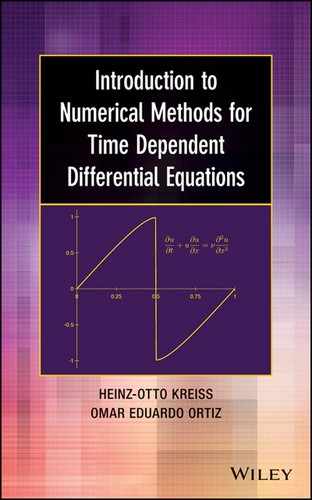PREFACE
This book is based on the class notes of a course that H. Kreiss taught in the Department of Mathematics at UCLA in the year 1998. The original notes were then used by many other people. In particular, O. Ortiz used those original notes in a course taught in Fa.M.A.F, Universidad Nacional de Córdoba, in 2007 and 2010. The positive feedback from students taking these courses encouraged us to write the book.
Our intention was always to write a short book, suitable for an introductory, self-contained course that places emphasis on the fundamentals of time dependent differential equations and their relation to the numerical solutions of these equations.
The book is divided into two parts. The first part, from Chapter 1 to Chapter 6, deals with ordinary differential equations (ODEs) and their approximations. Chapter 1 is a simple presentation of the fundamental ideas in the theory of scalar equations. Chapter 2 is the core of the first part of the book, where most of the important concepts on finite-difference approximations are introduced and explained for the most basic method of all, the explicit Euler method. The remaining chapters deal with higher-order approximations, implicit methods, multistep methods, and systems of ODEs.
Our intention in this book is to emphasize the principles on which the theory is based. This is, one first needs to understand clearly the theory of scalar ordinary differential equations with constant coefficients. Then the variable coefficient problems are approached by appealing to the principle of frozen coefficients, which allows one to split the variable coefficient problem into many constant coefficient problems. Nonlinear problems are treated via the principle of linearization, which turns a nonlinear problem into a linear variable coefficient problem, which then decomposes into constant coefficient problems via the principle of frozen coefficients. For systems of ordinary differential equations we require that we can diagonalize the system, and then we just need to understand scalar equations.
The second part of the book deals with partial differential equations in one space dimension and their approximations. The basics of Fourier series and interpolation are presented in Chapter 7. Chapters 8, 9 and 10 are devoted to the concepts of well-posedness and numerical approximations for both Cauchy problems and initial boundary value problems. We start the discussion by treating in detail three basic equations: the one-way wave equation (or advection equation), the heat equation, and the wave equation. In Chapter 11, the final chapter, we develop the idea of “when” and “why” nonlinear differential problems can be thought of as perturbation of a numerically computed solution, thus making the approximations meaningful.
We want to make clear that one first needs to understand the theory of differential equations, including estimates of the solution, after which one can prove the stability of the difference approximations by similar estimates. Therefore, the usual way is that one gets from the theory existence during a finite time, then one approximates the problem by difference approximations and computes the solution for as long as the approximation remains stable.
Exercises, with most of their solutions provided in an appendix, were included based on the conviction that solving exercises and computing are essential to the learning process of this subject.
All the software used in the preparation of the manuscript is open-source software run under GNU-Linux. The typeseting was done in LaTeX. The numerical computations for examples and exercises were written in C and compiled with gcc. The plots were generated using Gnuplot and Gimp.
HEINZ-O. KIRESS and OMAR E. ORTIZ
Córdoba
April 2013.
